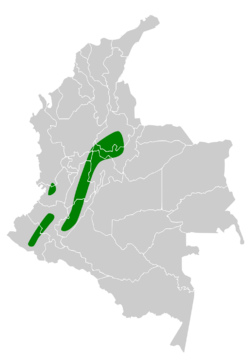Biology:Apical flycatcher
| Apical flycatcher | |
|---|---|

| |
| Scientific classification | |
| Domain: | Eukaryota |
| Kingdom: | Animalia |
| Phylum: | Chordata |
| Class: | Aves |
| Order: | Passeriformes |
| Family: | Tyrannidae |
| Genus: | Myiarchus |
| Species: | M. apicalis
|
| Binomial name | |
| Myiarchus apicalis Sclater, PL & Salvin, 1881
| |

| |
The apical flycatcher (Myiarchus apicalis) is a species of bird in the family Tyrannidae. It is endemic to Colombia. Its natural habitats are subtropical or tropical dry forests and arid and semi-arid open areas.
Taxonomy
The species was first described in 1881 by the English zoologist Philip Sclater.[2] The genus name derives the Ancient Greek muia - fly, and arkhos - ruler or chief. The species name comes from the Latin apical - of the point or tip - in reference to the white tips of the bird's tail feathers.[3] The species is monotypic, having no recognized subspecies.[4]
Description
The apical flycatcher is a typical representative of the Myiarchus flycatchers: a slim, medium-sized bird with few really distinctive features. The bird is 18-19cm in length, with greyish-olive upperparts. The wings are dusky, with whitish fringes to the tertials and coverts showing as two faint wing bars. The crown of the head is brownish-olive. The bird's throat and breast are pale grey. The underparts are mainly pale yellow. The tail is dusky with a greyish-olive underside. The tips of the tail feathers are white, which is diagnostic when compared to other Myiarchus flycatchers in its range.[5]
Males and females are identical in appearance. Juveniles have rufous fringes to their wing feathers.[5]
Distribution and habitat
The apical flycatcher is found in the tropical and temperate zones of Colombia at lower altitudes - from 400m and upwards. Authorities differ on the upper limit of their range, providing numbers between 1700-2500m.[5][6][7] The species is locally frequent in dry forest, arid and semi-arid open areas, savannas, and fields with scattered trees or light woodland, in the upper basins of the Magdalena River, the Cauca River and the Patiá and Dagua Rivers.[5]
References
- ↑ BirdLife International (2016). "Myiarchus apicalis". IUCN Red List of Threatened Species 2016: e.T22700424A93775083. doi:10.2305/IUCN.UK.2016-3.RLTS.T22700424A93775083.en. https://www.iucnredlist.org/species/22700424/93775083. Retrieved 12 November 2021.
- ↑ Sclater, P.L.; Salvin, Osbert (1881). "Descriptions of some new Species of South- American Birds of the families Tyrannidae and Formicariidae". The Ibis 4: 269. https://archive.org/details/ibis451881brit/page/268/mode/2up?q=Myiarchus+apicalis. Retrieved 8 January 2021.
- ↑ Jobling, James A. (2010). Helm Dictionary of Scientific Bird Names. London: Christopher Helm. pp. 51, 263. ISBN 978-1-4081-2501-4.
- ↑ Gill, F; Donsker, D; Rasmussen, P (Eds). "IOC WORLD BIRD LIST (10.2)". https://www.worldbirdnames.org/new/.
- ↑ 5.0 5.1 5.2 5.3 Restall, Robin; Rodner, Clemencia; Lentino, Miguel (2007). Birds of Northern South America: an Identification Guide. New Haven: Yale University Press. p. Vol 1 page 519. ISBN 978-0-300-10862-0.
- ↑ McMullan, Miles (2018). Field Guide to the Birds of Colombia. Bogotá: Rey Naranjo Editores. p. 281. ISBN 978-958-8969-77-0.
- ↑ Ayerbe Quiñones, Fernando (2018). Guía ilustrada de la Avifauna colombiana. Bogotá: Punto aparte. p. Pl 150. ISBN 978-958-5461-03-1.
Wikidata ☰ Q1270334 entry
 |


